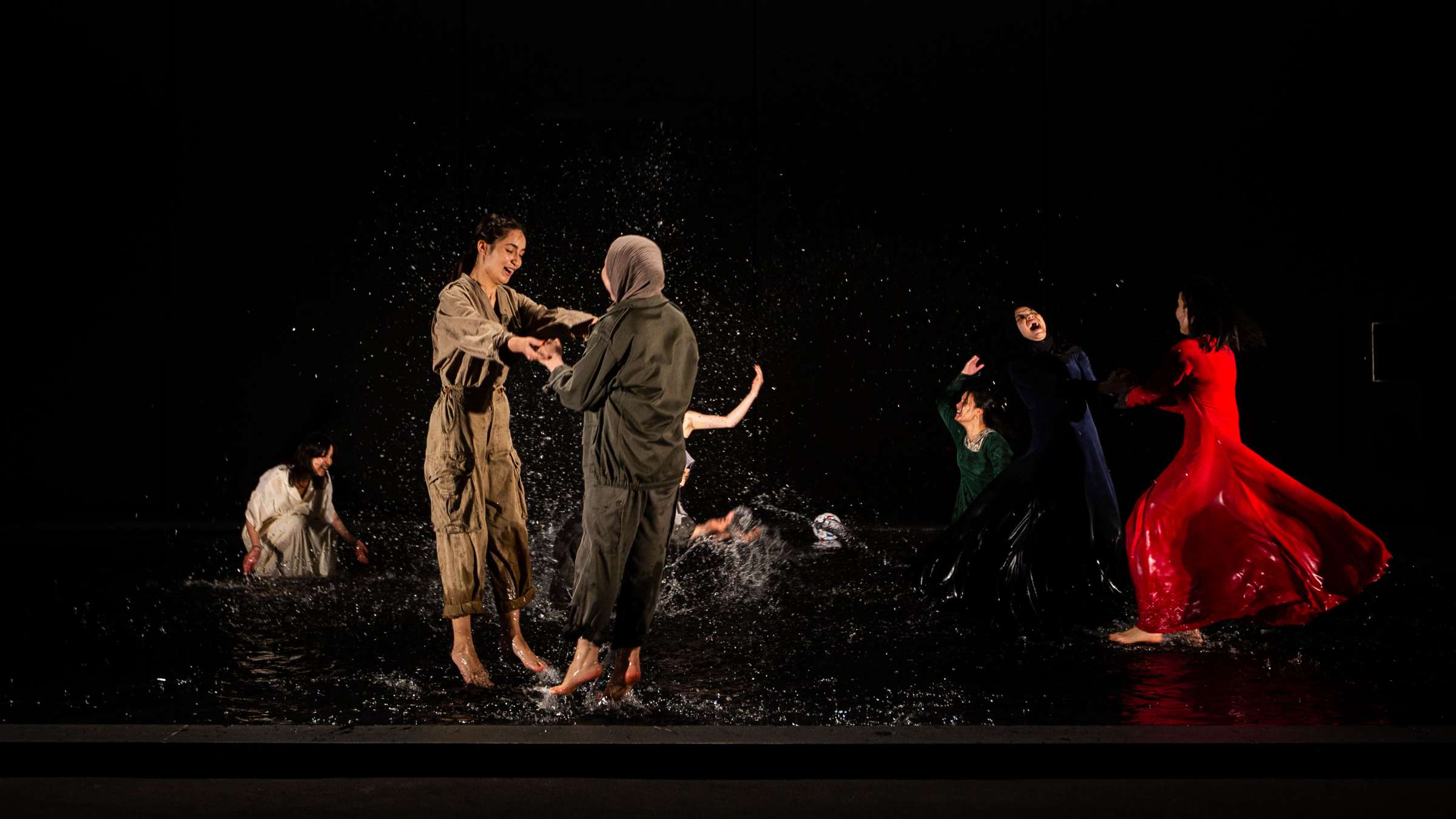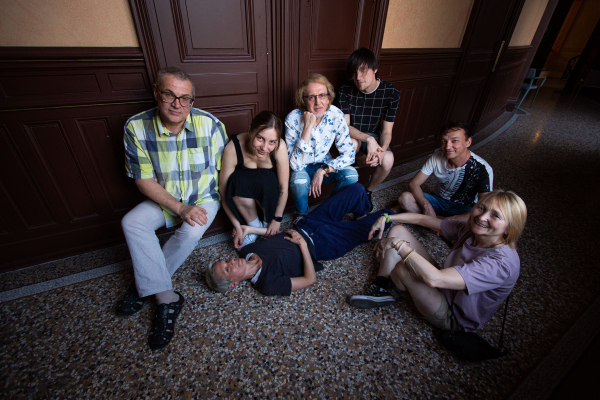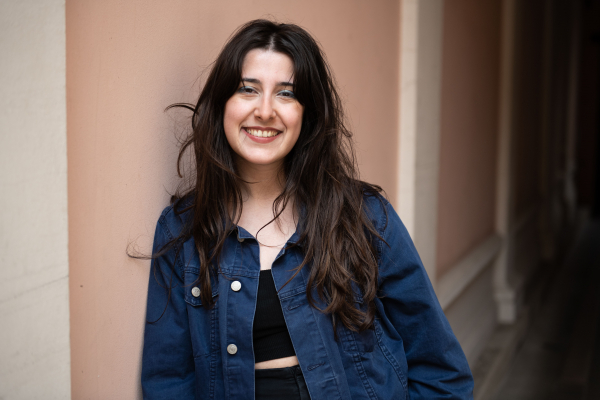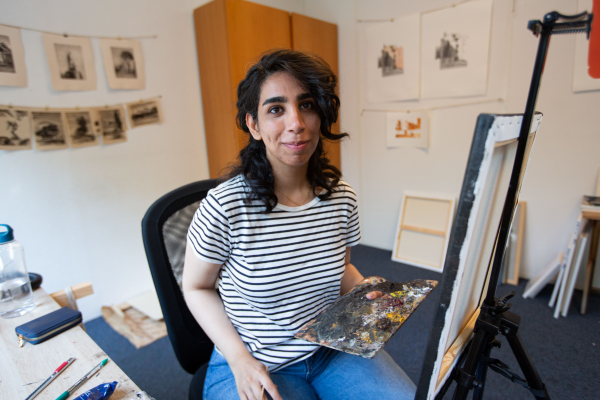Lyon, a creative home for artists in exile

Their names are Kateryna, Shegofa or Ghazale. In their homeland, continuing to paint, dance or play in total freedom has become impossible. From countries including Ukraine, Iran, Russia, Afghanistan and Lebanon, a handful of artists in exile has found refuge in Lyon to live, create and resist. This is our report.
When she left Kharkiv in March 2022, Kateryna thought that the war would be so short that she did not bring her instrument. One and a half years later, the 35-year-old musician, viola player and member of the philharmonic orchestra of Ukraine’s second largest city, has settled in Lyon, in the Croix-Rousse district. In the meantime, she has picked up her bow again and played dozens of concerts at the Lyon Auditorium (the concert hall of the Orchestre National de Lyon), which temporarily hosted her along with two other Ukrainian violinists. All three are among the artists in exile who have taken refuge in Lyon in recent years. Local cultural institutions, such as Théâtre des Célestins, Théâtre National Populaire (Villeurbanne), the Lyon BD comics festival, the association Le Grand Large, École des Beaux-Arts (school of fine arts), Théâtre Nouvelle Génération and Villa Gillet, have opened their doors to individuals for whom artistic expression was becoming dangerous in their home countries.“It was incredibly fortunate,” tells us Kateryna, speaking about the programme for classical musicians that was initiated by the Philharmonie de Paris, to help them find a place in a French orchestra. As she tells her story, her coffee goes cold. She forgets all about it in her eagerness to express her gratitude. “If I had not been able to continue doing my work, I would have fallen into depression,” says the young woman, who lived with a musician from the Orchestre National de Lyon before finding her own apartment. “The team was amazing, very welcoming and helped me a lot to overcome this uprooting. I hope that the Auditorium understands just how important their welcome was for us,” she says with a smile. The Auditorium’s director, Aline Sam-Giao, offered her a chance to continue to play one week a month until December 2023, in order to give her time to find a lasting solution if the war drags on, as it has in Yemen, the homeland of the young painter Afnan Yahya. Hosted by the city of Lyon, she took French classes for one year. She passed the entrance examination for the École Nationale Supérieure des Beaux-Arts (school of fine arts) and has also just been selected to take part in the upcoming Peinture Fraîche festival, to be held from the 11th of October to the 5th of November. Another one to watch is the Afghan Girls Theater, a company formed of nine Afghan actors, which was welcomed by Joris Mathieu in September 2021 as the dark shadow of the Taliban fell over Kabul once again. Together, they produced their first show ‘Le rêve perdu’ (the lost dream), before the company continued their adventure alongside Jean Bellorini, director of the Théâtre National Populaire. Their latest play, ‘Les Messagères’ (the messengers), is based on the ancient tragedy Antigone. The actors of Afghan Gir ls Theater – Hussnia Ahmadi, Freshta Akbari, Atifa Azizpor, Sediqa Hussaini, Shakila Ibrahimi, Shegofa Ibrahimi, Tahera Jafari, Marzia Jafari and Sohila Sakhizada – play characters including the heroine, her sister Ismene, the king Creon, Haemon and Eurydice, between a stage covered in water and a crepuscular sky. The play, which they perform in Dari (with French supertitles), deals with present-day issues: women’s emancipation, welcoming of the Other in exile, and artistic resistance in the face of those who would like to undermine culture. The show was performed to a packed house in June and is set to travel on a major tour in 2024.
Sens Interdits
When drama speaks out
Created in 2009 and held once every two years, the festival Sens Interdits defends a “theatre of urgency” and art that speaks out, offering insights into issues that are a cause of revolt around the globe, including Cameroun, Mali, Rwanda, Lebanon, Russia and Byelorussia, Palestine, Iran and Brazil, as well as in Metropolitan France, Guadeloupe, Réunion and Martinique. The 18 shows in the 2023 edition, scheduled at 22 venues, will be accompanied by mediation actions, masterclasses, meetings and debates, to give spectators as many ways as possible to understand topics that are rarely discussed.
14 to 28 October
www.sensinterdits.org
Three questions for Pierre-Yves Lenoir
Recently appointed as Director of the Théâtre des Célestins, after holding the role of co-director for four years.
You have decided to give an important role to artists in the management of your theatre. Why?
There used to be a permanent artist here, Claudia Stavisky, who co-directed the theatre and carried out her creative work in Lyon. It is very important to me that the Théâtre des Célestins remains a place of creativity. There will be four teams there in the coming years with very different views on drama, art and society, as well as very singular, sometimes opposing worlds. For me, this reflects the rich palette of theatrical art today.
Among these teams, there is the dissident Russian company KnAM. How did you meet them?
Patrick Penot, one of my predecessors here, who knows Russia and Eastern Europe well, introduced me to them. He met them in their little 23-seater theatre on the ground floor of a building in Komsomolsk-on-Amur, a city in eastern Siberia, where they worked in conditions of great insecurity. He invited them here to work with Claudia Stavisky as part of the festival Sens Interdits. Since then, Théâtre des Célestins has supported all of their productions. Our collaboration has evolved since the beginning of the war in Ukraine. They have been hosted in offices and we have tried to find accommodation for them, which has not been easy. The artist-producer relationship has not changed all that much; we are still very present by their side, but we are no longer alone today, as their work has been noticed by quite a few other theatres in France, Switzerland, Belgium… As of next season, I would like them to be partner-artists of Théâtre des Célestins, as a logical extension of our shared work.
How has this work with exiled artists fed into your plans for Théâtre des Célestins?
It has been an absolutely unique opening into the outside world, offering ways to better understand things happening in countries as complex as Russia. How is it that artists, men and women, find themselves prevented from expressing themselves and creating? Things happening over there are becoming absolutely impossible to live with for people who are attached to freedom of expression and creation. This direct dialogue with them is irreplaceable. We are, of course, informed by the media, but we are suddenly given a deeper understanding of the complexity of the situation.
Nous ne sommes plus… (we are no longer…) – a creation by Tatiana Frolova and the company KnAM, in residence at Théâtre des Célestins. 17 to 28 October 2023.
Portraits
Théâtre des Célestins
KnAM: a story of dissidence at Théâtre des Célestins
In 1999, when Jean-Pierre Thibaudat, Russia correspondent at the French newspaper Libération, came across the programme of the company KnAM, he was amazed. The repertoire was so different from what he had been used to seeing in Moscow’s theatres that he jumped on a plane to travel the 9000 kilometres between Paris and Komsomolsk-on-Amur, in eastern Siberia. Tatiana Frolova and her team moved him so deeply that he invited them to perform at the festival Passages in Nancy, which he co-directed. He also introduced them to Patrick Penot, director of Théâtre des Célestins and the Lyon-based festival Sens Interdits. KnAM returned there every two years and established itself as one of the festival’s highlights. When the war broke out, in February 2022, it had already been many months since the company, which was fiercely opposed to Putin, no longer dared to perform its shows. “Laws required the closure of theatres showing irreverence towards the authorities. It was very risky,” tells us Tatiana, surrounded by her whole company, in one of Lyon’s municipal theatres. The eight actors, who have been refugees between the rivers Rhône and Saône for a year, have just obtained political asylum. They tell us about their fears when it came to leaving, their journey through Kyrgyzstan and their arrival in Lyon via Théâtre des Célestins. “It really was a group effort to help get KnAM out of Russia,” smiles Bleuenn Isambard, a member of the company, as she translates their story into French.
In its work, the small dissident company performs documentary drama, mixing together real interviews, audio and video, with classical texts, such as those of Goethe and Dostoevsky. Their next creation – Nous ne sommes plus… (we are no longer…) – will be presented in mid-October in Lyon, before setting off on a tour. It draws inspiration from their exile: Tatiana asked each of them to show the 23 kg that they were able to take with them when leaving their country, to show on stage what actors in danger put in their suitcases.
Today, they have all found places to live between Guillotière, Bellecour and Vieux-Lyon. “I don’t feel like I have the right to go out on the street and ask for anything, as I feel like I haven’t contributed enough to this place yet. However, I feel that I have support and people are taking care of me. It’s very touching,” explains Lucia, the last to join the company. “It’s so beautiful here; sometimes I see the sun set behind Fourvière and I say to myself that I could die now,” continues the young lady. Around her, everybody laughs, sharing her joy to be free.
Lyon BD
Laure Ibrahim reveals Lebanon through panels
On her Instagram account, colours burst out in all directions. Laure Ibrahim’s drawings are a reflection of herself: bright and funny, with a touch of melancholy. The young Lebanese comic book author and illustrator first studied at the Academy of Fine Arts in Beirut before working freelance for the Institut Français. In her comic strips, she explores her origins and the troubles of a country where the economic and political situation has become awful. “I’m not very scholarly or artistic, so comics are perfect for me! It can make very serious topics accessible; it’s kind of magical,” she says with a big smile. Aged 24 years, the young woman has founded a collective with thirty or so authors “to try to make something good at a time when everybody was struggling, particularly young people.” At the beginning of summer, she was welcomed for a two-month residence by the team of the Lyon BD festival, at the Collège Graphique. She was able to pursue her first publication project, alongside other international cartoonists. “The authors live between France and Lebanon, with one foot here and one over there,” explains Laure. She has fallen in love with Lyon, a city that is “so beautiful, where expression is possible.” The young artist can see herself living there: “I feel at home here; it’s similar to where I come from.”
Grand Large
Ghazale Bahiraie, love from Teheran to Lyon
China, Korea, Mexico, Iran, Thailand… The artists that have moved into the workshops of Le Grand Large, nestled in a large building near the Fagor-Brandt factory, come from various places around the world. Ghazale Bahiraie arrived from Teheran in September 2022, after having already spent several years in France. In her works, she uses various mediums, such as embroidery, video and drawing, exploring Persian symbols and motifs. “I’ve always been engaged in the fight against what is happening in Iran,” explains the 33-year-old artist, who came to Lyon “for love” when her husband studied here. When she presented her portfolio, one of the series on war in the Middle East and its consequences on the lives of children caught the eye of Isabelle Bertolotti, president of the association and director of the Musée d’Art Contemporain (Museum of Contemporary Art). She joined Le Grand Large a few months later, with three other Iranian artists.




